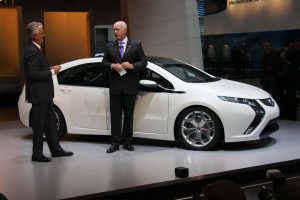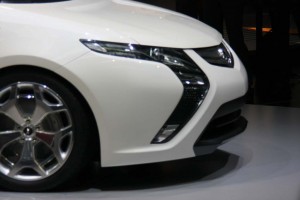
Despite the financial crisis at Opel, the German maker intends to launch its extended-range electric vehicle, the Ampera, in late 2011. Opel CEO Carl-Peter Forster (c) says it will be "very close" to the concept version appearing at the 2009 Frankfurt Motor Show.
The crisis surrounding Opel, the German subsidiary of General Motors, hasn’t delayed the planned launch of the maker’s extended-range electric vehicle, or EREV, the Ampera.
Sharing much of its fundamentals with the U.S. EREV, the Chevrolet Volt, the Opel Ampera will still reach market during the second half of 2011, confided Frank Weber, the program manager, during an interview at the 2009 Frankfurt Motor Show.
There has been plenty of concern about Opel’s product plans considering the operation has bordered on bankruptcy, in recent months. The German-based operation has survived only with the financial assistance of the Berlin government – though German leaders pressed GM to relinquish a controlling stake in the company, in return. Last week, the U.S. maker confirmed it would sell 65% of Opel to a consortium led by parts supplier Magna International. The deal could be completed within the next 8 weeks, officials have confirmed.

The distinctive LED headlights will be a signature feature on the Opel Ampera "E-REV," but the wheels and tires add significantly to the vehicle's overall energy efficiency.
The sale dominated Opel’s Frankfurt news conference, though company officials desperately tried to shift the spotlight to their newest models, including the latest version of the compact Astra, and a prototype of the Ampera. The show car, said Opel CEO Carl-Peter Forster is “very close to the production version.”
In keeping with European sensibilities, the 2012 Opel Ampera is less of a crossover/ute than the Chevy Volt, with a shape somewhere between a conventional sedan and a hatchback – a style popular on the Continent. One of the most distinctive features is he design of the LED headlamps, which sweep upwards from the front bumpers, hooking across the top of the fenders.
Like Volt, however, a critical element of the design was maximizing aerodynamics. The original Chevy prototype was estimated to deliver about 35 miles per charge of its Lithium-Ion batteries. The production version will top 40, largely due to tweaks of its body meant to better cheat the wind.
Weight is another factor, noted Weber, stressing that mass is the enemy of range in an electric vehicle. In some cases, the effort to improve Ampera’s efficiency focused on seemingly minute details. Like its wheels, for example.
The 5-spoke design is close to the signature Opel design, but it is both more aerodynamic and lighter in weight, the engineer noted. The wheels on the Volt, he noted, are already about 20% lighter than conventional wheels. Ampera is again 10% lighter.
“When we worked on the Volt,” which will beat Ampera to market by at least half a year, “we saw there was even more potential to enhance the vehicle’s design and improve its battery range, said Weber.
